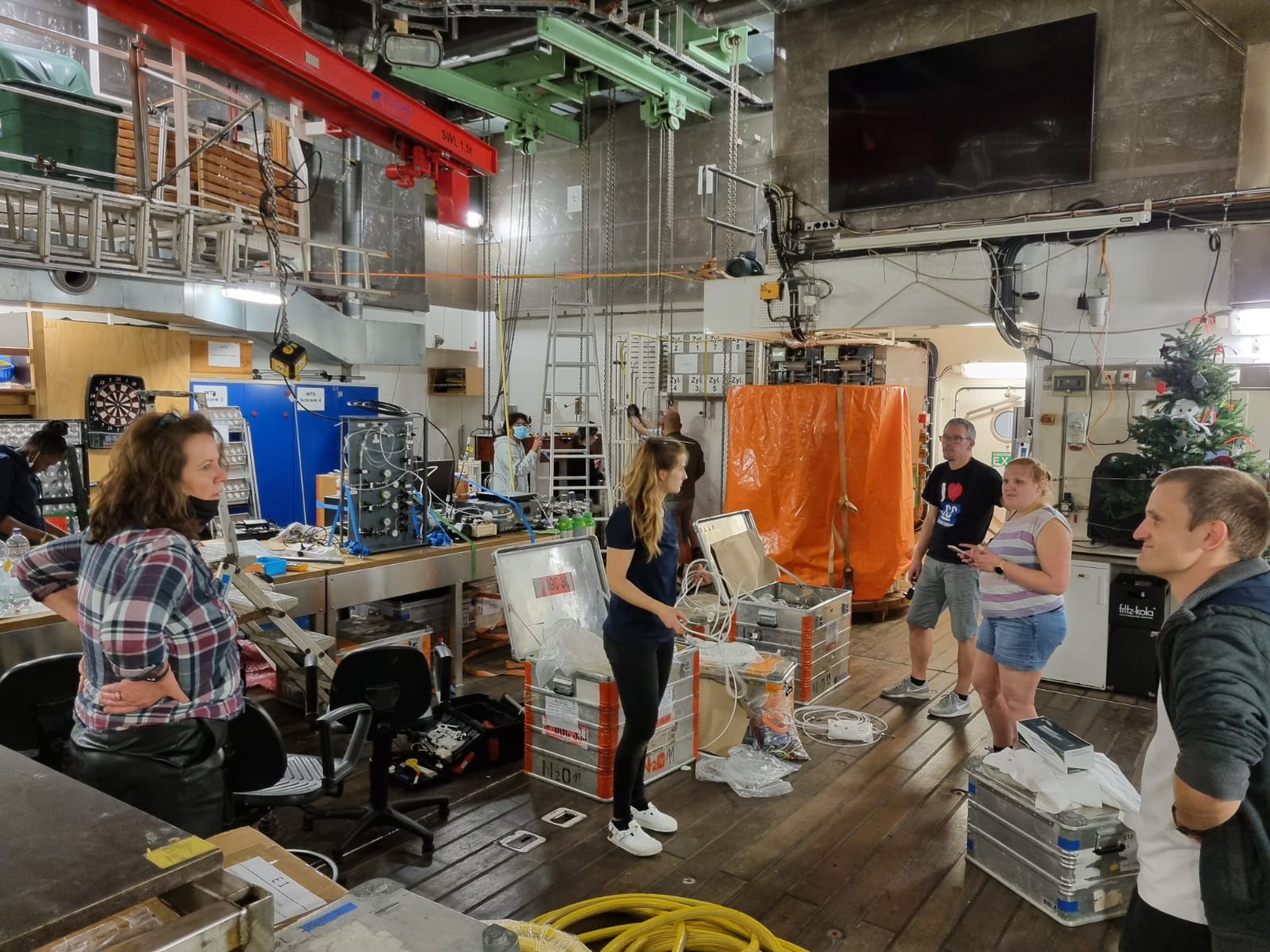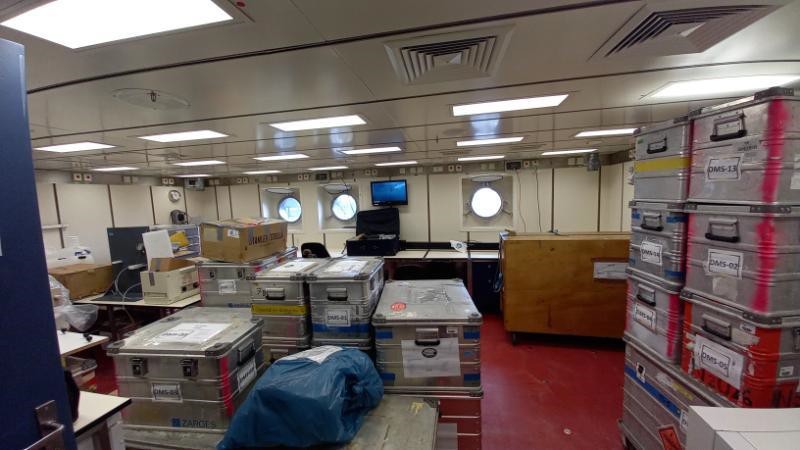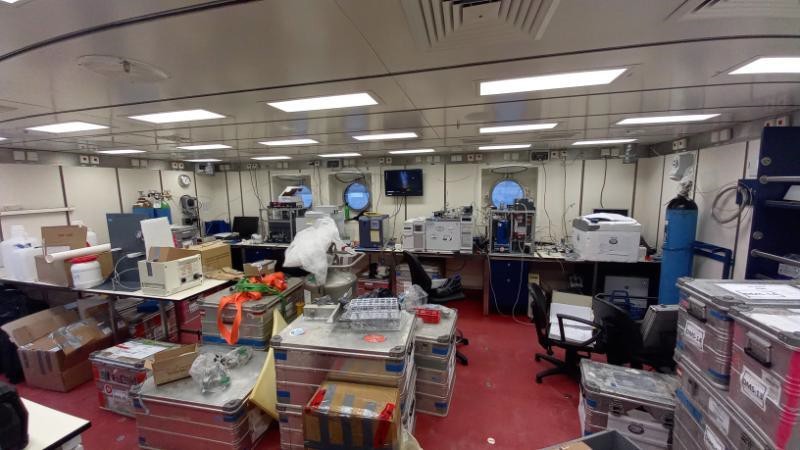-English version below-
Es ist zwei Uhr nachts und ich komme gerade vom Bug der Sonne, wo ich eine unserer ersten Luftproben in einem Edelstahlbehälter, der ein bisschen so aussieht wie ein Rugbyball, gesammelt habe. Als die Probenpumpe warm laufen musste, hatte ich wieder einmal ein paar Minuten Zeit in den dunklen Himmel über dem Ozean zu schauen, der mit dem intensiven Blinkern der Millionen Sterne, die hier draußen so gut sichtbar sind für die viele Mühen der intensiven Vorbereitungszeit dieser Expedition entschädigt.
Nun sind wir endlich hier angekommen, nachdem uns im Juli dieses Jahres unser Forschungsantrag für die vierwöchige Expedition quer über den Atlantik bewilligt wurde. Mehrere Anträge, tausende von E-Mails, Telefonaten, Formularen, Videokonferenzen, Verträgen, Unterschriften, Akquisitionen, Bescheinigungen und Fragebögen später erreichten wir nun den großen Strom, der Meerwasser von Afrika über den Atlantik in die Sargassosee und bis in die Karibik transportiert. Die biogeochemischen Prozesse, die auf dieser Reise ablaufen, sind bislang kaum erforscht. Daher werden wir, ein internationales Team aus 39 Wissenschaftlern zusammen mit der 30-köpfigen Besatzung des Forschungsschiffes SONNE über Weihnachten den Atlantik auf der Expedition SO287-CONNECT queren und dabei Tausende von Messungen vornehmen – auch um zu klären, wie diese Prozesse mit dem Klimawandel verknüpft sind.
Obwohl der Atlantik mehrere Tausend Kilometer breit ist, stehen die Wassermassen im Westen und Osten dieses großen Ozeans eng miteinander in Verbindung. Vor Westafrika steigt nährstoffreiches Wasser aus der Tiefe auf und fördert an der Meeresoberfläche das Wachstum von pflanzlichen und tierischen Kleinstlebewesen und Fischen. Ein Teil des Wassers wird von einer großen Strömung – dem Nordäquatorialstrom – bis zum Golf von Mexiko und in die Karibik verfrachtet. Dieser Wassermassen-Transport ist so wichtig, weil mit ihm große Mengen an organischem Material auf den offenen Ozean gelangen. Für Mikroorganismen wie Bakterien wirken sie dort wie ein Lebenselixier. Doch wie diese nahrhaften Reste der Algen und andere Substanzen auf ihrer weiten Reise von Mikroorganismen verarbeitet, biochemisch umgewandelt, zu Nährstoffen zersetzt und zu Kohlendioxid veratmet werden, ist bisher nur lückenhaft erforscht. Deshalb sind wir am 11. Dezember 2021 von Las Palmas de Gran Canaria in Richtung Westen aufgebrochen, um bis in den Pazifik hinein an vielen Stellen Wasserproben zu nehmen und Spurenstoffe in der Atmosphäre zu messen. Nachdem die SONNE den Panama-Kanal passiert hat, wird sie am 11. Januar 2022 ihren Zielhafen in der ecuadorianischen Hafenstadt Guayaquil erreichen.
Auf unserer Route folgen wir den Wassermassen bis in die Sargassosee wo wir mit zwölf Nationen Weihnachten feiern werden. Auch an Weihnachten werden wir die Luft und das Meerwasser beproben, um neue Details über die großen Kreisläufe von Kohlenstoff und Stickstoff, aber auch von vielen anderen Elemente, wie Sauerstoff, Jod, Brom, Schwefel und Phosphat zu liefern. Wie sind biogeochemische und ökologische Prozesse über große Entfernungen hinweg miteinander verbunden und wie groß sind die Stoffmengen, die zwischen Meer und Atmosphäre ausgetauscht werden?



Wir untersuchen Jodverbindungen und andere Spurengase aus dem Meer, welche die Bildung von Wolken fördern können und das Klima beeinflussen. Wie stark wird Sargasso-Tang, den wir hoffen während der Expedition beproben zu können, Jod und halogenierte Kohlenwasserstoffe an die Atmosphäre abgeben? Darüber hinaus steigen aus dem Meer generell auf ganz natürliche Weise Brom- und Jod-Verbindungen in die Atmosphäre auf und gelangen teilweise in die Stratosphäre, wo sie zum Abbau von Ozon beitragen. Wir werden daher genau messen, wie viel dieser Verbindungen an welchen Orten frei werden und wie sie im Meer und in der Atmosphäre umgewandelt werden. Dazu messen wir die Spurenstoffe an Bord in den Meerwasserproben und der Luft mit modernster Technik. Außerdem untersuchen wir in Lagerungsversuchen den Einfluss verschiedener natürlicher Parameter wie Temperatur und Sonnenstrahlung auf die biogeochemischen Umwandlungsprozesse, um den Einfluss des Klimawandels auf die Prozesse zu verstehen.
Interessant ist für uns auch, wie der rege Schiffsverkehr auf dem Atlantik die Stoffkreisläufe im Meer beeinflusst. So werden über die Schiffsabgase große Mengen an Stickoxiden in das Wasser eingetragen. Unklar ist, in welchem Maße diese auf den natürlichen Stickstoffkreislauf einwirken. Viele Schiffe sind heute mit Abgasreinigungsanlagen ausgestattet, die Schwefelverbindungen aus den Abgasen auswaschen. Welchen Einfluss das dabei anfallende schwefelhaltige, saure und schmutzige Wasser auf Organismen und biochemische Prozesse im Meer hat, untersuchen wir ebenfalls. Wir nutzen die Gelegenheit, Plastikabfälle im Meer mit einen Fangschlitten zu erfassen und ihren Beitrag zu globalen biogeochemischen Umwandlungsprozessen zu untersuchen.
Mit dieser Fahrt ist das Forschungsschiff SONNE nach einer längeren Zwangspause, während derer aufgrund der Corona-Pandemie nur Fahrten auf dem Atlantik durchgeführt werden konnten, endlich wieder in eines seiner wichtigsten Einsatzgebiete – den Pazifischen Ozean – aufgebrochen. Wir Fahrtteilnehmer sind alle doppelt und dreifach geimpft und haben PCR-Tests vorlegen müssen, um die Seereise antreten zu dürfen und tragen auch jetzt noch Masken, bis wir absolut sicher sein können, dass kein Virus unsere Forschung und Stimmung ruiniert. Wir sind überglücklich, dass wir diese ungewöhnliche Expedition, die uns die Möglichkeit gibt, ganz grundlegende Fragen im Detail zu erforschen, durchführen können. Während der gesamten Fahrt werden wir regelmäßig mittags zum höchsten Sonnenstand und mitten in der Nacht Wasserproben nehmen. Vor allem der Vergleich der Messwerte vom Mittag und aus der Nacht wird interessant sein, weil die Sonnenstrahlung viele biogeochemische Prozesse beeinflusst. Dass wir über Weihnachten unterwegs sein werden, macht uns angesichts der einmaligen Gelegenheit zu dieser Expedition nichts aus. Weil es ein besonderer Zeitraum ist, können manche Kolleg*innen jedoch nicht mitfahren. Viele Studenten haben aber die Gelegenheit für ihre Masterarbeiten ergriffen und freuen sich auf Weihnachten in der Sargassosee und Silvester in der Karibik, was eine kurze Entspannung zu den Arbeiten rund um die Uhr auf der Expedition verspricht.
Aber zunächst einmal sind viele Augen rot und man schaut heute in viele müde Gesichter, da anderthalb Tage Aufbauzeit kompletter Labore, von der Ankunft der Ausrüstung bis zum Start der Expedition vorgestern und dem Messbeginn vier Stunden später, sehr viel Kraft, Energie, Organisation und Durchhaltevermögen erfordern. Einige Studenten sind zum ersten Mal auf einem Forschungsschiff und haben den Aufwand für ein gutes Gelingen der Experimente und Probenahmen unterschätzt. Auch die Schiffsbewegungen und die viele anfallende Arbeit und Dinge, die man lernen muss, um Probenahmen zu realisieren fordern ihren Tribut. Ganz zu schweigen von den Massen an Proben, die plötzlich vorhanden sind, nachdem die 288 Liter Meerwasser aus verschiedenen Tiefen in den 24 Flaschen des Kranzwasserschöpfers an die Oberfläche gelangt sind, und zwanzig Personen in hunderten unterschiedlichster Behältnissen das Wasser in die Labore getragen haben, wo es nun verarbeitet werden muss. Aber davon erzähle ich nächste Woche. Es bleibt nur noch zu erwähnen, dass trotz der momentanen Erschöpfung alle gut drauf sind und eine sehr angenehme und heitere Stimmung an Bord herrscht. Hoffen wir mal, dass es so bleibt und wir unseren erfolgreichen Anfang fortführen können.
Mit herzlichen Grüßen verbleibt das Team von SO287-Connect
Birgit Quack, Fahrtleiterin SO287-CONNECT
GEOMAR Helmholtz-Zentrum für Ozeanforschung Kiel
english version
A good start to the big measurement cruise across the Atlantic
It’s two o’clock in the morning and I’ve just come from the bow of RV SONNE, where I collected one of our first air samples in a stainless steel container that looks a bit like a rugby ball. As the sample pump was warming up, I once again had a few minutes to look up into the dark sky over the ocean, which compensates for the many efforts of the intense preparation time of this expedition with the intense twinkling of the millions of stars that are so visible out here.
Now we have finally arrived here after our research proposal for the four-week expedition across the Atlantic was approved in July of this year. Several proposals, thousands of emails, phone calls, forms, video conferences, contracts, signatures, acquisitions, certificates and questionnaires later we made it to the large current, which transports seawater from Africa across the Atlantic to the Sargasso Sea and all the way to the Caribbean. The biogeochemical processes that occur during this journey have been poorly understood. Therefore, we, an international team of 39 scientists together with the 30 crew of the research vessel SONNE will cross the Atlantic over Christmas on the expedition SO287-CONNECT, taking thousands of measurements – also to clarify how these processes are linked to climate change.
Although the Atlantic is several thousand kilometers wide, the water masses in the west and east of this large ocean are closely interconnected. Off West Africa, nutrient-rich water rises from the deep and promotes the growth of plant and animal microorganisms and fish at the
ocean surface. Some of the water is carried by a large current – the North Equatorial Current – as far as the Gulf of Mexico and the Caribbean. This water mass transport is so important because it carries large amounts of organic material to the open ocean. For microorganisms such as bacteria, they act there like an elixir of life. But how these nutritious remnants of algae and other substances are processed by microorganisms on their long journey, biochemically transformed, decomposed into nutrients and respired to carbon dioxide, has so far only been incompletely researched. Therefore, on December 11, 2021, we set out west from Las Palmas de Gran Canaria to take water samples at many locations all the way into the Pacific Ocean and to measure trace substances in the atmosphere. After passing the Panama Canal, RV SONNE will reach its destination port in the Ecuadorian city of Guayaquil on January 11, 2022.
On our route, we will follow the water masses to the Sargasso Sea where we will celebrate Christmas with twelve nations. Also Christmas we will sample air and sea water to provide new details about the large cycles of carbon and nitrogen, but also of many other elements, such as oxygen, iodine, bromine, sulphur and phosphate. How are biogeochemical and ecological processes linked over large distances, and how large are the amounts of substances exchanged between the ocean and the atmosphere?
We are studying iodine compounds and other trace gases from the ocean that can promote cloud formation and affect climate. How much will Sargasso kelp, which we hope to sample during the expedition, release iodine and halogenated hydrocarbons into the atmosphere? In addition, bromine and iodine compounds are generally emitted naturally from the ocean into the atmosphere, and some reach the stratosphere where they contribute to ozone depletion. We will therefore measure exactly how much of these compounds are released and at what locations, and how they are transformed in the ocean and in the atmosphere. To do this, we will measure the trace compounds on board in the seawater samples and the air using state- of-the-art technology. We are also investigating the influence of various natural parameters such as temperature and solar radiation on the biogeochemical transformation processes in incubation experiments in order to understand the influence of climate change on the processes.
We are also interested in how the busy shipping traffic on the Atlantic influences the material cycles in the ocean. For example, large quantities of nitrogen oxides are introduced into the water via ship exhaust. It is unclear to what extent these affect the natural nitrogen cycle.
Today, many ships are equipped with exhaust gas purification systems that remove sulfur compounds from the exhaust gases. We are also investigating the impact of the resulting sulfurous, acidic and dirty water on organisms and biochemical processes in the ocean. We are taking the opportunity to capture plastic debris in the ocean with a fishing skid and investigate its contribution to global biogeochemical transformation processes.
With this voyage, the research vessel SONNE has finally set sail again for one of its most important areas of operation – the Pacific Ocean – after a long forced break due to the Corona pandemic, during which cruises just on the Atlantic Ocean were possible. All of us on the cruise have been double and triple vaccinated and have had to submit PCR tests in order to be allowed to embark on the voyage, and we are still wearing masks until we can be absolutely sure that no virus will ruin our research and mood. We are overjoyed to be able to undertake this unusual expedition, which will give us the opportunity to explore very fundamental questions in detail. Throughout the cruise, we will be taking water samples regularly at noon at the highest position of the sun and in the middle of the night. It will be particularly interesting to compare the readings from midday and from the night, because solar radiation influences many biogeochemical processes. The fact that we will be traveling over Christmas does not bother us, given the unique opportunity for this expedition. However, because it is a special period, some colleagues were not be able to join. However, many students have taken the opportunity for their master’s theses and are looking forward to Christmas in the Sargasso Sea and New Year’s Eve in the Caribbean, which promises a short relaxation to the round-the- clock work on the expedition.
But for now, many eyes are red and many tired faces are seen today, as a day and a half of setting up complete labs, from the arrival of the equipment to the start of the expedition the day before yesterday and the start of measurements four hours later, requires a lot of strength, energy, organization and stamina. Some students are on a research vessel for the first time and underestimated the effort, which is required to make experiments and sampling go well. Also, the ship movements and all the work involved and things that need to be learned to make sampling happen take their toll. Not to mention the masses of samples that are suddenly available after the 288 litres of seawater from various depths have reached the surface in the 24 bottles of the bottle-rosette, and twenty people in hundreds of different containers have carried the water to the labs where it must now be processed. But I’ll tell you about that next week. It only remains to mention that despite the current exhaustion, everyone is in a good mood and there is a very pleasant and cheerful atmosphere on board. Let’s hope that it stays like this and that we can continue our successful start. With best regards, the team of SO287-Connect will see you next week.
Birgit Quack, Chief-scientist of SO287-CONNECT
GEOMAR Helmholtz Centre for Ocean Research Kiel
